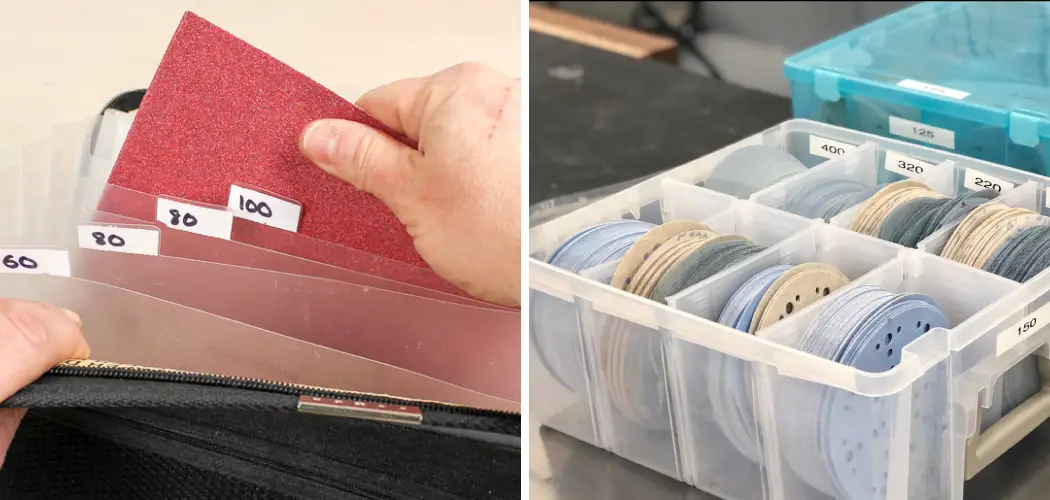Are you wondering how to store sandpaper the right way? Whether you’re an experienced woodworker or simply a DIY enthusiast, it’s important to know how to do it properly.
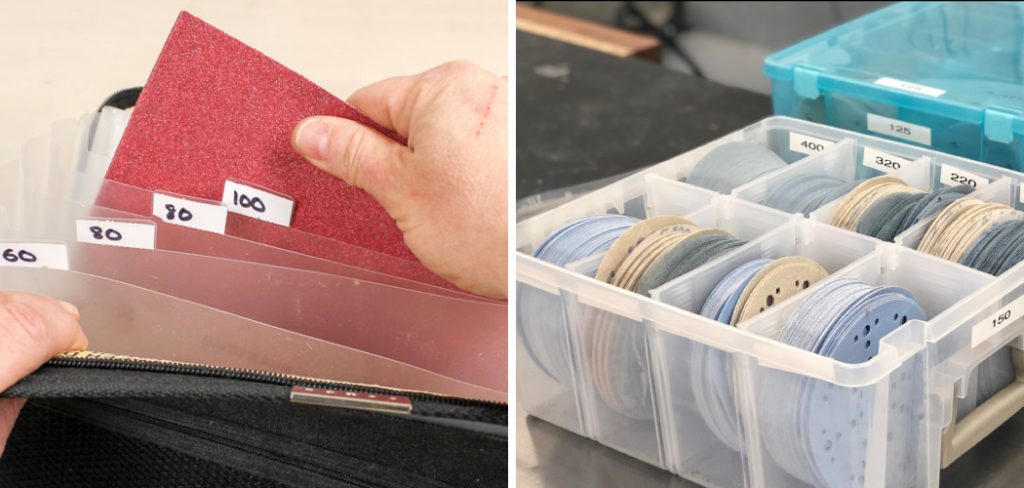
When it comes to keeping your space organized, having the right supplies and tools can make a world of difference–and that especially goes for sandpaper! Many don’t realize that storing it properly is essential, as it can help keep you from wasting precious materials or ending up with scratched project surfaces.
Whether you use sandpaper often in your projects or just have some on hand in case of emergency repairs, learning how to store it correctly could be one step towards becoming a more organized crafter!
In this blog post we will cover all the best ways to store sandpaper so that you can make sure your supplies are always there when you need them.
What Will You Need?
To store sandpaper, you will need the following:
- Sandpaper of your choice
- Plastic storage container with a lid
- Labels (optional)
- Pen/marker (optional)
- Cardboard (optional)
Now that you have everything ready let’s get started!
10 Easy Steps on How to Store Sandpaper
Step 1: Choose the Right Container
The first step is to choose the right container for your sandpaper. When selecting a storage container, be sure to pick one with a tight-fitting lid so that moisture and dust don’t get in and ruin your supplies. A plastic storage bin or box is ideal since it won’t rust like metal containers can.
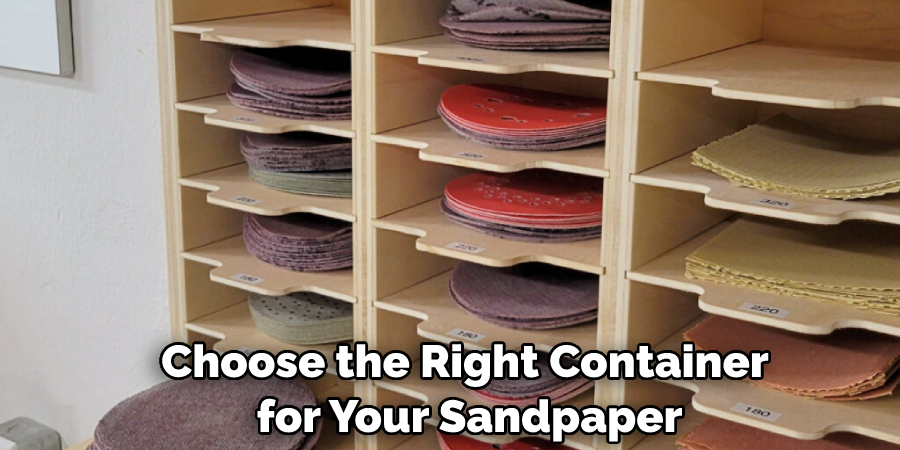
Step 2: Label Your Sandpaper Containers
If you want to keep track of how many pieces of sandpaper you have on hand, try labeling each container with its contents. This way, you’ll know exactly how much paper you’re working with. Whether you label it with a pen/marker or use adhesive labels, labeling your sandpaper containers will make storage much easier!
Step 3: Sort Sandpaper By Grit
Next, sort your sandpaper by grit (the size of the abrasive particles). This will make finding the right paper for a project much faster and easier since you’ll be able to pull out the specific type of paper you need without having to search through all of them. Be careful to avoid cross-contamination of grits, as this can ruin a project.
Step 4: Separate Your Sandpaper
Once you have sorted your sandpapers by grit, separate each sheet from the others. This will help prevent any pieces from sticking together when stored in the container, as well as making it easier to pull out exactly how much you need for a project. If you’re using a plastic container, try putting cardboard in between the sheets to help keep them from sticking.
Step 5: Place Each Sheet on the Cardboard
Before stacking each sheet in the container, place them on a piece of cardboard. This will help prevent scratching or damage to the paper while it’s stored away. Any kind of cardboard should work fine, but if you have extra-thick pieces lying around, those could be even better!
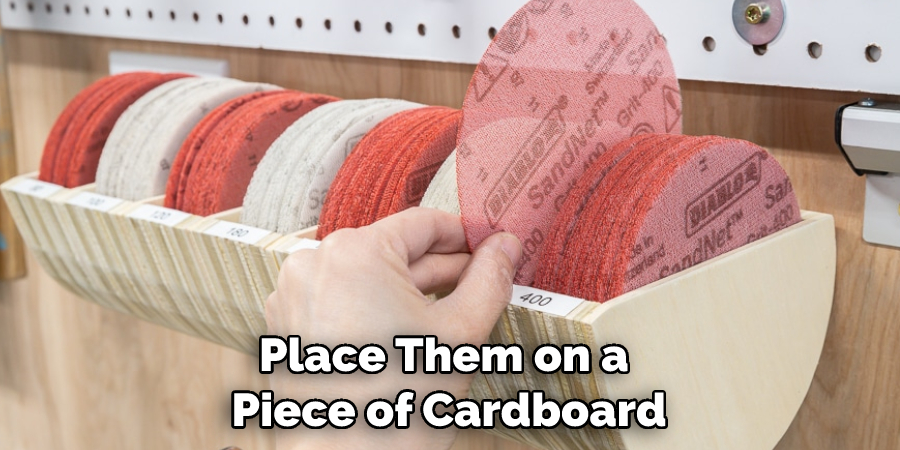
Step 6: Stack Sandpaper Sheets Neatly
Once all your sandpapers are separated and placed on cardboard, stack them neatly in the storage container–just like how you would stack books! This will ensure that no pieces get bent or creased when stored away. If you’re storing a lot of sandpaper, try stacking by grit to make it easier to find what you need later.
Step 7: Place a Lid on the Containers
Finally, place a lid on each container to remove dust and moisture. This will help preserve your sandpaper and ensure it’s ready when needed! You can even tape down the lids for extra protection if you want.
Step 8: Store in Cool, Dry Places
When storing sandpaper, be sure to put them in cool and dry places away from sources of heat or sunlight. These conditions are necessary for preserving the paper over time, as excessive heat or humidity may cause the paper to degrade faster. You can use closets, cabinets, or drawers for extra protection.
Step 9: Rotate Your Sandpaper Supply
It’s important to remember to rotate your supplies. This means that you should go through your stock every so often and replace any old or worn-out pieces with new ones. Rotating your supplies will ensure you always have the best paper for the job!
Step 10: Reevaluate Your Storage Needs
Finally, be sure to reevaluate your storage needs from time to time. As your sandpaper supply grows or changes, adjust how they are stored accordingly to ensure everything is properly organized and easy to find when needed. It will also help you stay on top of how much paper you have left and when it’s time to restock.
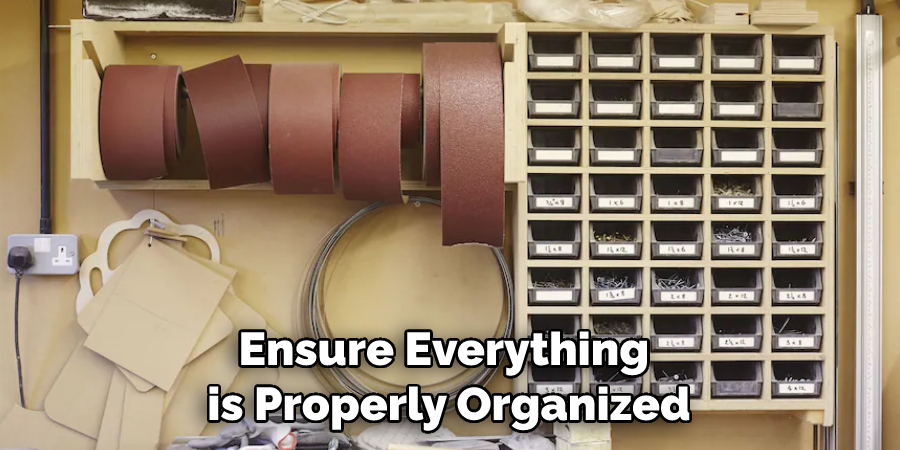
By following these steps, you can store sandpaper properly and ensure you’re always ready for any project that comes along! With a little bit of organization, your sandpaper storage will be organized and efficient.
5 Additional Tips and Tricks
- Store different grades of sandpaper separately to avoid confusion when searching for the right grade at a later time.
- Keep sandpaper away from extreme temperatures such as direct sunlight or cold locations like attics and basements.
- Sandpaper should be stored on its own shelf or rack, away from tools that may damage it or cause it to become wet over time (e.g., power tools).
- Label the containers used for storage so you can quickly identify their contents without opening them up. This will save valuable time and make your workshop more efficient overall!
- Consider using a portable storage container that can be moved around the workshop and stored out of the way when not in use. This allows you to easily access your sandpaper without moving heavier items or climbing ladders.
By keeping these tips in mind, you can find the perfect way to store your sandpaper and keep it safe for future projects. Good luck!
5 Precautions You Can Take
- Use a dedicated container to store sandpaper. This will help keep dust from accumulating and make it easier to find the paper when needed.
- Place sandpaper in an airtight container. This will ensure that moisture does not accumulate and damage the grit of the paper over time.
- Sort your sandpaper by grade or type and clearly label each container, making it easy to find what you’re looking for when you need it.
- Store sandpaper away from direct sunlight, which can cause fading or discoloration over time.
- Keep your sandpaper flat to reduce the risk of warping or curling due to humidity and temperature changes.
These simple storage tips will help you preserve your sandpaper and ensure it’s ready to use when it comes!
How Can I Extend the Life of My Sandpaper?
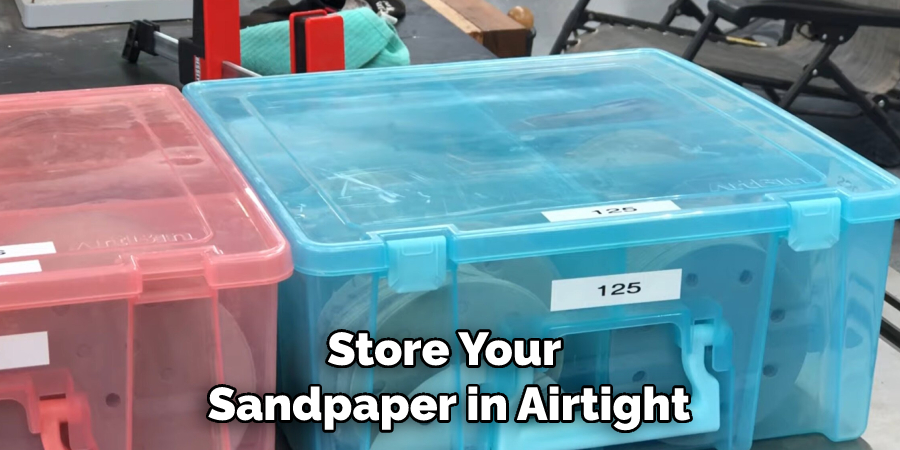
- Only use sandpaper when it’s absolutely necessary, and clean any particles off of it after every use.
- Store your sandpaper in airtight, dry containers away from direct sunlight, dust, and moisture.
- Place a piece of cardboard between the sheets to keep them straight and flat when not in use.
- Avoid using excessive pressure when sanding to reduce the wear on the paper surface.
- Replace any worn or damaged pieces with new ones as soon as possible to ensure maximum effectiveness.
By following these simple steps, you can extend the life of your sandpaper and get more value out of each sheet! With proper storage and care, your supplies will be ready and waiting for the next project.
Why Do You Need to Soak Sandpaper in Water?
Soaking sandpaper in water will help keep the paper flexible and prevent it from drying. This is especially important if you are using wet/dry sandpaper, as this type of paper requires water to be effective. Soaking the paper before use can also increase the abrasive power of the grit, making it more efficient at removing material.
However, it’s important to note that not all sandpaper is designed for soaking; check with the manufacturer before submerging any type of sandpaper in liquid. When done properly, soaking can extend the life of your sandpaper and provide better results when working on projects!
Conclusion
Just how important it is to store your sandpaper properly cannot be overstated. If stored correctly, the lifespan of your sandpaper will increase substantially, and your projects will ultimately benefit from this. The next time you purchase a batch of sandpaper, make sure to remember the tips outlined in this blog post. Keep your jointing boards sanded evenly and make sure to sort your paper by coarseness level. Lastly, ensure that you store the paper properly both when using it and when not using it.
Doing the above steps can make the difference between great results with your projects and poor ones. Sandpaper is an essential item for successful projects; use it correctly and follow these tips, and you’ll be well on your way to amazing results each and every time!
Hopefully, this blog post has provided you with enough knowledge to make sure how to store sandpaper and how to extend its lifespan. With the right storage techniques, your sandpaper will be ready whenever you need it! Good luck!
You Can Check It Out to Restore Faded Polywood Furniture

